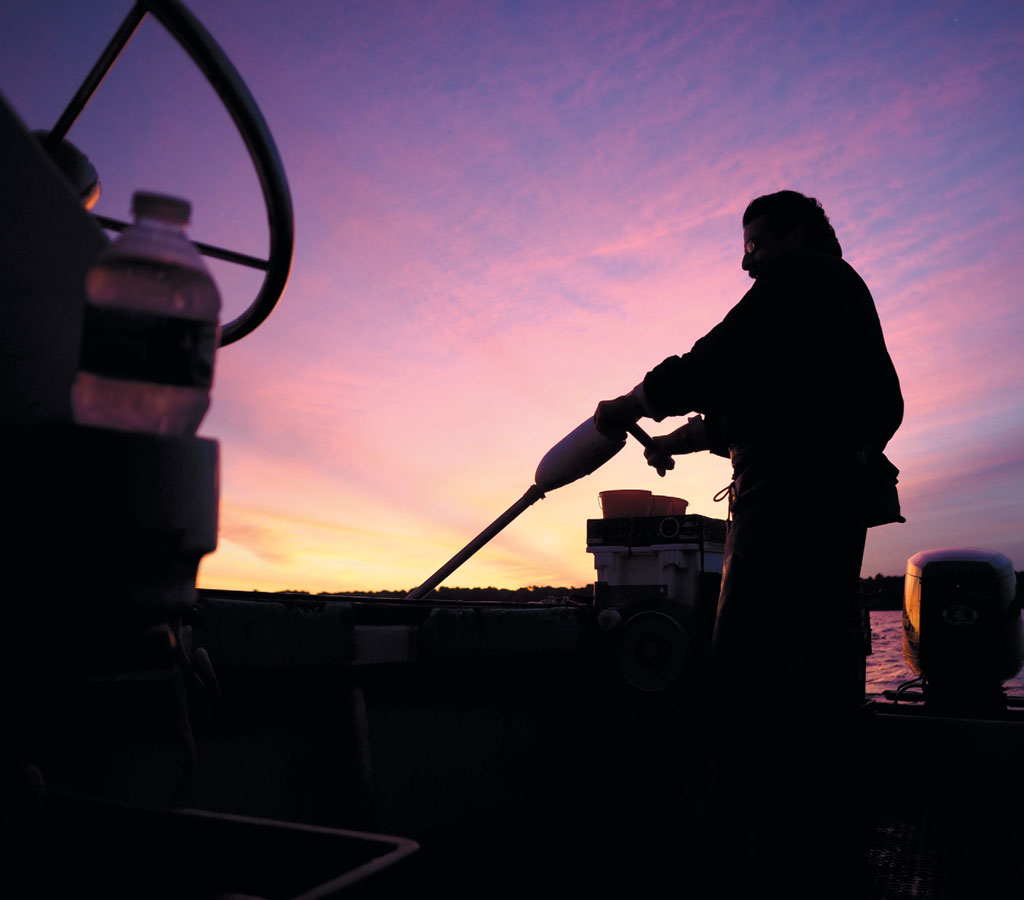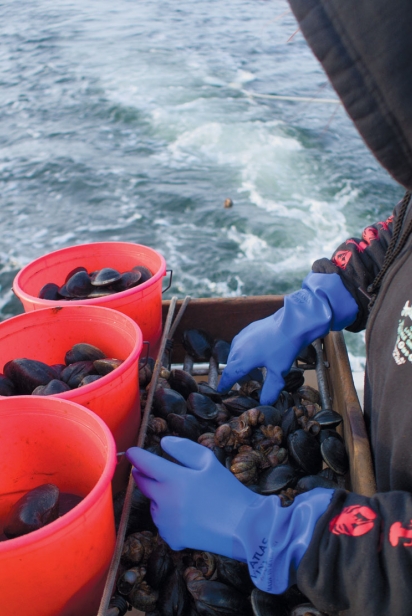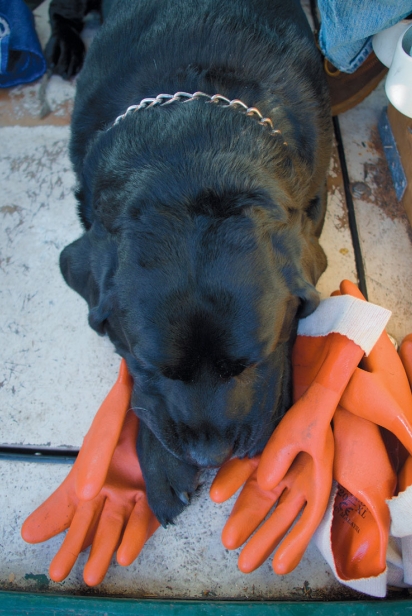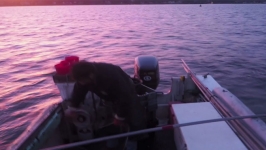Andrade’s Catch
Wild-Harvested Quahogs Keep a Family Business Thriving in Bristol
Dave Andrade’s life as a quahogger began when, as a young man, he learned the trade from his uncles, gradually developing an intimate relationship with the saltwater ecosystems of Narragansett Bay. As his knowledge increased, he began wild harvesting clams commercially.
In 1987, he and his wife, Gigi, purchased a small retail shop near Bristol Harbor in the East Bay. The Andrades moved into the apartment above the shop and began selling fish and chips with fresh-caught fish from New Bedford. They called it Andrade’s Catch.
The Andrades’ fish and chip business thrived for more than a decade, with Gigi at the helm in the kitchen while Dave continued to enjoy his days out on the water clamming. As their family grew, instead of expanding into a bigger space, they squeezed three more into their small apartment.
The kids—Davy, Chelsea and Nikki—grew up in the thick of the business: out on the water with their father; by their mother’s side running a busy shop; and sharing meals made of local fish. For the Andrades, family life and business life blended together while they remained close, as they are today.
As time went on and Gigi’s health took a turn, the fish and chip business took a back seat to quahogging. The family suspended the fish and chip side of the business in 2000. Today Andrade’s Catch is best known for its wild-harvested clams. Both son Davy, now 20, and daughter Chelsea, now 26, play a large role in the business. The family lost Gigi in 2006 but they operate Andrade’s Catch every day in honor of her spirit. This is evident even to an outsider.
Dave Andrade likens himself to a hunter/gatherer and is “at peace” out on the water, doing what he loves. As he heads out of Bristol Harbor towards Hog or Prudence Island, always with his dog, Digger, on board, he prefers dealing with what Mother Nature has to offer. Navigating many of the same stretches of the Bay for years, Andrade observes the many subtle changes in the natural environment. As the decades have passed, and the efforts to clean up Narragansett Bay have taken effect, he has seen the health of Bristol Bay’s waters improve dramatically.
“The water is cleaner than it was when I started,” he says. “And that’s good for everyone.”
Commercial quahogging is a physically demanding job. Clammers must pull and push a heavy rake into the bottom of the sea, over and over, for hours. Despite the physical challenges, up to 20 local clammers dig for Andrade’s and take their haul directly to the shop every day. The clammers are greeted by Chelsea, who feeds the clams through a clever sorting contraption. The machine sits in the front of the retail shop where customers can see it in action.
Judging by the amount of activity at the Andrades’ clam-counting machine, it would appear that quahogs are relatively abundant in Rhode Island waters. This is true—but it has taken some work to get to this point.
In response to a decline in the quahog population in the 1980s and ‘90s the state put a moratorium on the number of clamming licenses available. The aim was to slow the depletion of the resource and maintain economic viability for those quahoggers already licensed. Since then the Rhode Island quahog population has stabilized as the state’s policy has been to issue a license to just one newcomer for every licensed quahogger who leaves the industry.
“We have reached a period of stability; the numbers of licenses out there can sustain themselves on the quahogs available,” says Jason McNamee, chief of marine resource management at the Rhode Island Department of Environmental Management. “Until there is an increase in quahogs, we are not inclined to open up the licenses—so that the current populations of quahogs and quahoggers can thrive.”
For a lifelong quahogger like Andrade, who sees abundant clams everyday, there is a concern that with so few people able to enter the industry, its future is in jeopardy. “I would like to see more people, especially young ones, out there making a living clamming,” he says.
Maintaining his already close-knit operation, Andrade purchased the commercially zoned property across the street from his shop in 1997. He lives there now and Davy is planning to take over the apartment once renovations are complete. The zoning allows Andrade to house his lobster tanks in a shed behind the house. The lobsters are local or New England caught and available in the summer months.
Andrade also keeps his boat, named Gigi after his wife, at his aunt’s house around the corner. It is the same boat he has been fishing from since he started the business, the same boat his kids and dogs grew up on. Almost 30 years later, it is still serving him well.
The majority of Andrade’s Catch retail customers are East Bay locals who stop in regularly for fresh-dug quahogs. They also can purchase other fish brought in daily from New Bedford (cod, scallops, etc.), as well as steamers, conch and wild-harvested oysters from Connecticut and Buzzards Bay. Chelsea and Samantha Bay, who also helps run the shop, are there working with quahoggers and helping customers, answering questions and guiding purchasing.
“Dave’s oysters and littlenecks have been part of my shopping list for 14 years,” says regular customer Mark Alano. “I buy a lot of fresh fish now too. Dave is a staple in the community and we’re lucky to have him.”
Richard Oakland, who not so long ago relocated to Bristol from Connecticut, is in the shop once, if not twice, a week. Often the clam sorter is running at the same time. “I love that the quahoggers are right there and I know the clams are fresh.”
Andrade’s quahogs make their way into local restaurant menus as well. Providence’s Al Forno has been sourcing clams from Andrade’s since 1988. From the founding of their renowned restaurant, Johanne Killeen and her late husband, George Germon, were known for being particular about their purveyors. The two requested to spend a day out on water with Andrade. As Andrade recalls, “They were very inquisitive [about the process and the quality of the clams].”
From that day a relationship evolved that still holds strong today. Al Forno’s executive chef, David Reynoso, still orders clams exclusively from Andrade. It’s often Andrade himself, if not his son Davy, who makes the delivery.
“We’ve never had the need to try clams from somewhere else. There is nothing comparable to the wild clams that he digs,” said the chef. On his spring menu Chef Reynoso likes to steam littlenecks with other fresh fish, as well as calamari. He adds a little white wine, olive oil, lemon juice and fresh fava beans when they are available.
In addition to Al Forno, Andrade’s sells clams to Hemenway’s and Capital Grille, as they’ve been doing for over 20 years.
Dave Andrade is a man of the water—his first love. With this foundation his family and his business grew, slowly and with great care. The evidence that he is doing things right is in freshness of the quahogs and fish that come to Andrade’s Catch every day— and the contented customers who trust in the Andrade family and their product.
Andrade’s Catch
186 Wood St., Bristol, RI
401-253-4529; AndradesCatch.com
Shell Game
All hard-shell clams are called quahogs (pronounced KO-hogs). Quahogs are then divided and named by size. From smallest to largest: Count neck (also called littleneck) is the smallest, followed by top neck, cherrystone and, finally, chowder (sometimes called quahog).









